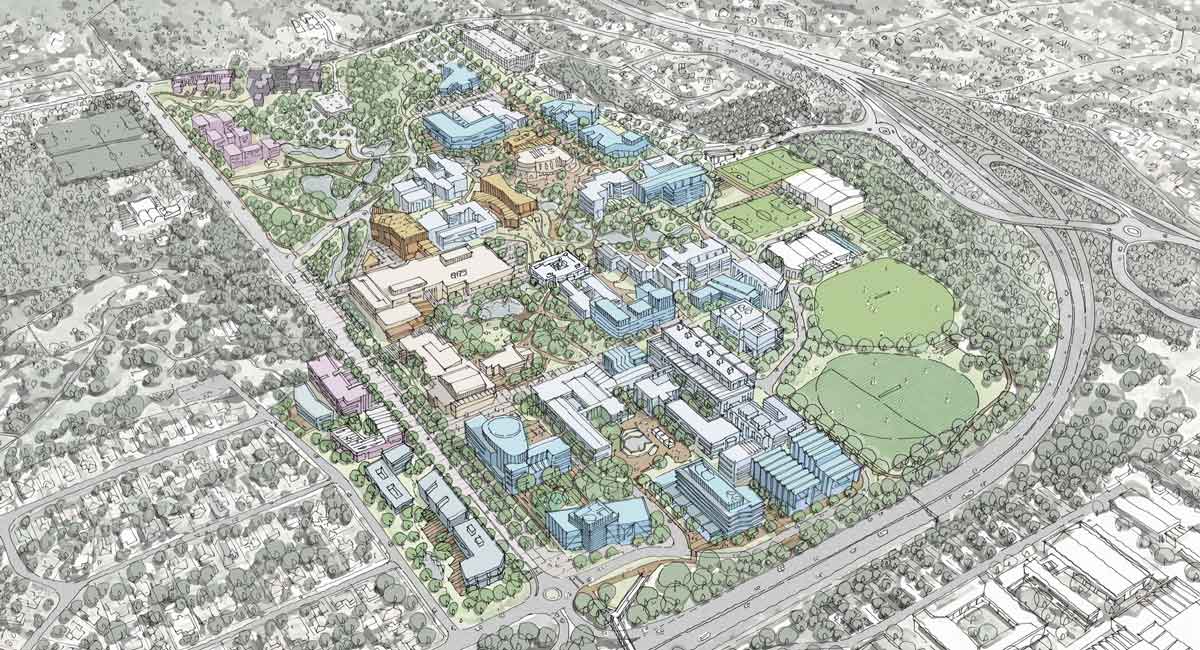August 23, 2016
Campus Master Plan a guiding vision for the future
Twenty year plan to transform Wollongong’s world class institution.
The University of Wollongong (UOW) has unveiled its 2016–2036 Wollongong Campus Master Plan, a document that guides the future direction and planning for the University over the next 20 years.
The Campus Master Plan is the single largest unified planning exercise ever undertaken by the University since its humble beginnings in 1962 on the site of a former dairy farm, where it provided training for engineers, metallurgists and industrial chemists for the heavy industry in the post-war era.
Increasing enrolments and infrastructure demands to support the University’s ambitions to be in the global top 1 per cent for teaching and research require careful thought be given to the physical development of the Wollongong Campus.
The Campus Master Plan includes a number of key guiding principles to fulfill long-term goals and objectives:
- Upgrading Northfields Avenue to be the principal face of the University and gateway to adjoining neighbourhoods.
- Working with NSW Roads and Maritime Services to plan a new northern gateway as part of the proposed Mount Ousley interchange.
- Developing typically 4 to 5 storey academic buildings, in keeping with tree heights and maintaining campus views.
- Introducing pedestrian-friendly gateways and improved facilities for cyclists and public transport users to encourage people to use these options instead of private cars.
- Preserving and potentially increasing green space by redeveloping existing buildings and using car park areas for development.
- Creating campus precincts that build on existing faculty identities and embrace the wide-ranging biodiversity and landscape.
- Digital technologies that will enable flexible use of spaces for learning, teaching and administration.
- Continuing key sustainability measures to reduce energy consumption and waste.
The Campus Master Plan draws on ideas and concepts from professionals, staff, students, community members and government agencies to ensure it builds on the high-quality landscape and public realm of the existing campus, while improving its relationship to the surrounding community.
The plan has involved months of research and consultation, led by campus master planners, MGS Architects, to ensure a thorough and integrated understanding of the complexities of the campus environment.
Consultation with students, staff, local business, government and the wider community was at the core of the planning process. More than 40 consultation sessions were held to gather the views and ideas of a wide range of stakeholders and their valuable input will help shape the University's future.
The extensive consultation process involved engagement sessions with the staff and students as well as the broader Wollongong community, with more than 500 people attending consultations at forums, meetings and information stalls on campus and at community events.
Chief Administrative Officer Melva Crouch said the Campus Master Plan was an in-depth planning exercise that considered growth needs in light of the University’s growing campus population and its important role in the economic, social and creative contribution to the region.
“The Wollongong Campus is a complex space and a key part of preparing this visionary document has been reaching out to the community, campus users and government agencies to ensure we considered the widest possible range of needs and ideas, supported with best-practice in master planning,” Ms Crouch said.
“To achieve our goals of being a global top 1 per cent teaching and research university, we will need to grow student numbers at the Wollongong Campus by 3,000 over the next 20 years.
“To accommodate this number of students will require around 80,000 square metres of additional floor space. That’s the equivalent of eight new buildings the same size as the recently completed Early Start facility.
“With those needs in mind, as well as the Campus’s role in the Illawarra, the vision looks at the campus identity, how we enrich the campus experience and how we cater for growth, in particular reducing car dependence and preserving our much-loved green spaces.
“As we implement the vision, we will continue to work in partnership with Wollongong City Council and NSW Government agencies to align our plans with the broader needs and vision for the region.”
Vice-Chancellor Professor Paul Wellings CBE said the Campus Master Plan supports the recently released 2016–2020 Strategic Plan, particularly addressing the goal of sustaining a vibrant environment enhanced by natural beauty.
“We are firmly part of Wollongong city and the Campus creates a welcome and safe environment,” he said.
“Our Strategic Plan sets out that capital expenditure plans will release in excess of $300 million within the next five years, so we need to plan thoughtfully as we respond to changing academic and research needs and a growing student population – including having more students living on campus.
“Maintaining the right environment, that includes world-class facilities and attractive public spaces, will help the University reach its ambitions while continuing to foster valuable local links and encouraging staff and students to fulfill their potential.”
